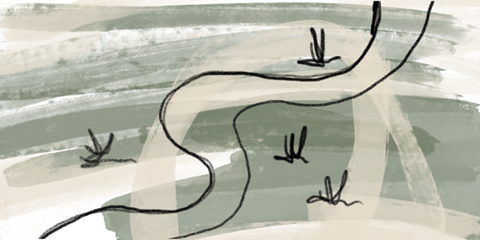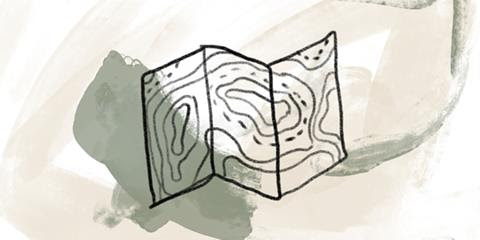My spiritual journey has been a journey in edge-walking with many companions who cherish the mystical, justice and sacramental treasures in Catholicism but live their prophetic call in violation of Church laws and outdated dogma. I am grateful to Richard Rohr for this inspirational meditation.
Edge Walking
Cofounder of the Wild Church Network, Victoria Loorz introduces “edge walkers” who connect across faith traditions:
My personal spirituality is rooted in the Christ tradition—a term I prefer over Christian, which is a label I find difficult to swallow these days. Rather, I see myself as an “edge walker,” wandering along the hemlines of the Christ tradition. I stand at the inside edge of a tradition that has brought many people, including me, deep pain and has also brought many people, including me, deep joy and meaning…. I’ve adopted this term, edge walker, from nature writer Terry Tempest Williams. [1] The Encyclopedia of Religion and Nature describes her edge walking as traveling “the narrow space between the religious tradition she credits for having ‘forged her soul,’ and her direct and very personal experiences in nature that have revealed a truth of their own.” [2]
Perhaps you are an edge walker too. Edge walkers occupy a thin space and are by definition a bit lonely. Most people inhabit the vast spaces on both sides of edges. But those of us called to the thresholds—the edges between—live in this thin space and recognize one another when we meet. The edges between biosystems are called ecotones. These thresholds usually contain the most biodiversity and therefore are the most resilient….
The time is coming soon when the edges we inhabit will start to redefine the center. And we will need to lean on and learn from one another as we, together, engage in the work of that redefining. Each of us is characterized by our own unique gifts, communities of influence, and a particular bio-region. But we cannot behave as silos. The more diverse our relationships are, the more resiliently we can hold our own individual edges.
Loorz reminds us that mystics stand at the edges:
Every religion has an edge where the mystics live. I once attended a conference organized by Ed Bastian, a Buddhist mystic whose calling is defined by his deep respect for and encouragement of interfaith spirituality. He gathered spiritual leaders from diverse traditions to consider what we had most in common: living on the same planet….
We talked about how our faith traditions could connect us with the actual soil and water and creatures of Earth. And how that connection could be a spiritual foundation for the environmental movement. What I remember most was a golden thread of mystical connection with divine presence that all of us expressed in our relationships with the natural world. Even in our diversity, we all felt that we had more in common with one another—edge walkers from other traditions—than we did with people more firmly planted in the center of our own faiths....
There have always been edge walkers: those who didn’t follow along with the status quo, who didn’t swallow the version of religion offered by those on top of the hierarchy as The Only Way. And at that edge, spirituality and nature are in unbroken relationship.
[1] Benjamin Webb, “In Search of Our Fugitive Faith: Terry Tempest Williams,” in Fugitive Faith: Conversations on Spiritual, Environmental, and Community Renewal (Maryknoll, NY: Orbis Books, 1998), 163.
[2] Sarah McFarland Taylor, “Williams, Terry Tempest,” in Encyclopedia of Religion and Nature, vol. 2, K–Z, ed. Bron R. Taylor (New York: Continuum, 2005, 2008), 1752.
Victoria Loorz, Church of the Wild: How Nature Invites Us into the Sacred (Minneapolis, MN: Broadleaf Books, 2021), 14–16.
Image credit: A path from one week to the next—Izzy Spitz, momentary peace (detail), digital oil pastels. Taylor Wilson, Transfiguration (detail), cyanotype. Taylor Wilson, Madonna and Messiah, ink. Used with permission. Click here to enlarge image.
Transformation happens on the margins (the edge of the inside), and so, like this bird, we are freed.
Story From Our Community
Over the past year, my experience of God and faith have been evolving. I was feeling adrift when I realized that I could no longer pray to the God I had been taught about. I started searching for a new way of understanding my faith. The Center for Action and Contemplation has been my main source for unlearning and new learning in reading the Daily Meditations and listening to various podcasts. The truths the CAC shares have become my anchors. I am so grateful to be on a path that includes a much bigger, more inclusive God than the one I worshipped for so many years.
—Hilary L.
Share your own story with us.Was this email forwarded to you?
Subscribe now to the Daily Meditations.Sign-up for the monthly newsletter from the Center for Action and Contemplation for the latest news about our programs, including new books, podcasts, events, and online learning opportunities.
The work of the Center for Action and Contemplation is possible only because of people like you! Learn more about how you can help support this work.
If you would like to change how you receive these emails you can update your preferencesor unsubscribe from our list.







No comments:
Post a Comment